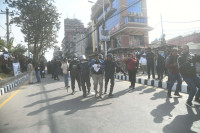Opinion
Theory of everything
Communicating science effectively can help do away with superstitions as demonstrated by media post-quake
Ananda Kafle
On a day following the 1988 earthquake, my grandmother gathered us around her and explained how earthquakes happen and how terrible they can sometimes be.
“There lies a deep ocean under the earth, on the surface of which all our lands remain floating. But the water alone cannot prevent this heavy mass of rocks, trees and soil from sinking. There also lives a giant elephant, which is as tall as the depth of the ocean, so that the back of the elephant is on the surface while its feet are still on the base. It holds the entire earth on its back. After carrying the earth for several years, it gets tired and shifts the load to the other side for relief. And that is when the earth shakes. If the elephant is annoyed due to the sinful deeds of humans, it gives some extra jerks causing more powerful quakes. And this is what happened in the 1934 quake.” As a witness to the 1934 earthquake along with the 1988 quake she had become some kind of a ‘quake expert’.
That huge animal
As young children, we did not have any reason to doubt her. Our collapsed house in a village close to the epicenter in Udayapur district was a sufficient reason to lament for the humanly sacrileges that lead to disasters. While taking shelter in a dirty buffalo shed in rooms made by tarpaulins, we cursed the sinners. We remembered those rascals every single day when we had to face the chilling cold the following winter.
In the 1988 quake, which was quite small in magnitude as compared to the recent April 25 quake, a narrow belt including our village was significantly devastated. Immediately after the disaster, military helicopters started hovering in the skies and dropped relief materials. But there was no one to rescue me from the numerous questions that bothered me all the time. ‘How big would that creature have been? How much strength would it need to carry so many hills, mountains and trees on earth?’ Most importantly, regardless of its enormous power, how could a single animal stay standing for decades with such a heavy load on its back? Sometimes, I used to get scared while imagining the potential consequences in case the giant animal died. But I had to wait for a few more years to get the answers to my questions.
Belief in science
One day, when the aftershocks of the recent Nepal Earthquake had apparently ceased, my four-year-old daughter asked me, “Dad, so have the plates underneath the ground come to their correct positions?” Her question made me happy and at the same time realise the contrast between my own learning and that of my young daughter in our respective times. Even at such an early age, she is smart enough not to believe in any illusive explanation of a natural phenomenon like an earthquake. Unlike in my childhood, many children now-a-days have scientific insights. Many believe that ghosts and witches exist only in folk stories and not in the real world. These days, people in general have a more realistic understanding of everyday phenomena.
This is largely because of the improvement in communicating science. The freedom to publish and dissipate news and information combined with an easy access to a multitude of media including television and the internet has helped spread scientific awareness.
Communicating science
However, there are still many people in the rural as well urban areas continue to be superstitious, which often leads to racial and gender discriminations and harassments based on charges of witchcraft, among others. One good solution to these problems would be to further communicate science effectively. An effective science communication comprises the circulation of scientific ideas and discussions free from technicalities, so that even uneducated people can understand it. The involvement of people who have specialised in different fields would further enhance the impact of such messages. Post-quake, the Nepali media has presented an example of how scientific ideas can successfully be spread to raise social awareness and replace unfounded arguments.
A scientific understanding of things could help us do way with superstition and promote social integration. Scientific awareness also raises the self-esteem of the people and their ability to judge things. Thus, it is very important to enhance the scope of scientific communication. At the same time, it is also important to check inappropriate, pseudo-scientific hoaxes and claims spread by the people who would rather have others living in confusion.
Kafle is a PhD Student at Tokyo University of Science, Japan




 6.12°C Kathmandu
6.12°C Kathmandu










